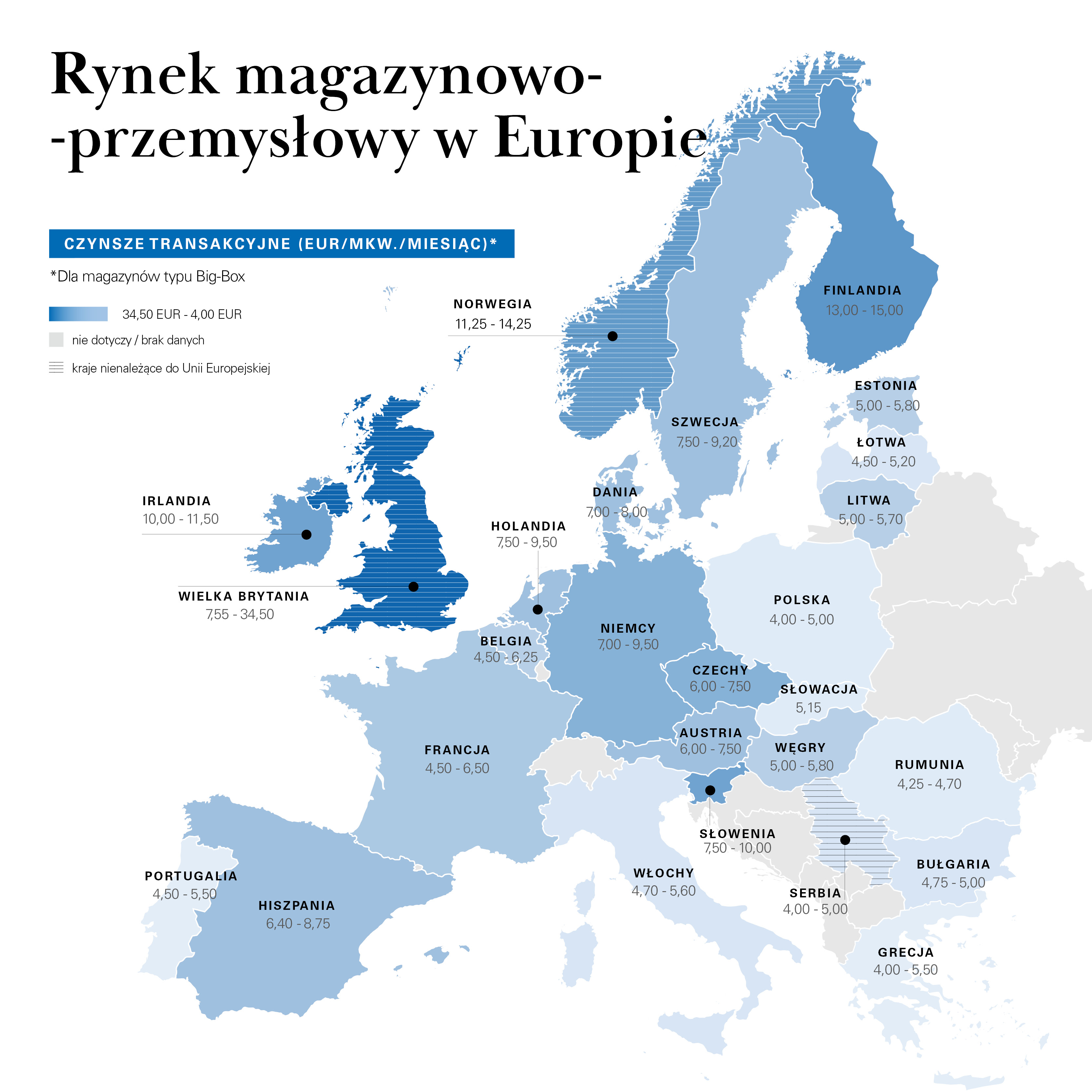Warsaw (12 November 2024) – According to “Industrial and Warehouse Market in Europe, H1 2024”, a report published by real estate advisory firm Newmark Polska, despite observed slowdown in occupier and developer activity, the European warehouse market continues to expand and is searching for a new equilibrium point. Green solutions are increasingly making their way into both warehouse facilities and logistics operations. Despite the challenges facing the warehouse sector across the European Union, this market shows strong growth potential, particularly in regions capable of adapting to new trends concerning both tenant needs and new regulations.
After the record years of 2021-2022, when take-up on the largest EU warehouse markets exceeded 35 million sqm each year, leasing activity has stabilized at an annual average of around 25 million sqm. The new level is close to figures recorded before the pandemic (in 2018- 2020) and in 2023, when net take-up (excluding lease renegotiations) was just over 27 million sqm. Subdued tenant activity is attributed to such factors as economic uncertainty, elevated interest rates and prolonged decision-making among companies. Total net take-up for the first half of 2024 reached nearly 11 million sqm, down by almost 10% year-on-year. Germany accounted for the largest share of the EU leasing volume (excluding renegotiated contracts) at over 22%, followed by Poland (15%) and France (12.7%).
Significant variations persist in leasing activity across the EU. Many countries recorded year-on-year declines in the first half of 2024 – these included the Czech Republic, France, Hungary and Germany, which posted decreases of 34%, 23%, 8% and 5% respectively. In contrast, Poland stood out in the region, seeing an increase of over 20%.
“Faced with a selective approach to new project financing and weaker occupier demand, developers are also exhibiting considerable caution. Warehouse development activity has been on a downward trend across the EU since 2021. At the end of June 2024, there was approximately 15 million sqm of warehouse space under construction, marking a decrease of over 20% year-on-year,” says Jakub Kurek, Head of Industrial & Warehouse at Newmark Polska.
Countries experiencing heightened development activity include Italy (more than 2.3 million sqm under way), Poland (nearly 2 million sqm) and France (almost 1.8 million sqm). Speculative construction as a share of total stock under construction is also decreasing, particularly in locations recording high vacancy rates. At the end of June 2024, speculative projects accounted for less than 40% of the total development pipeline.
The slowdown in development activity, coupled with shrinking land availability, has led to a decline in new warehouse supply which totalled approximately 8 million sqm across the EU in the first half of 2024, marking a decrease of nearly 20% from the same time a year earlier. It is important to note that almost 40% of this space (new supply) remains vacant.
“With nearly 1.65 million sqm of new deliveries, Poland led the way for construction activity. Significant additions were also recorded in the Netherlands and Sweden, which saw 1.1 million sqm and 900,000 sqm come on stream respectively,” adds Jakub Kurek.
Muted occupier and developer activity pushed the overall EU vacancy rate up to just above 5% at the end of June 2024, with increases recorded on the majority of the surveyed warehouse markets. The lowest vacancy rates were in Italy (2%) and the Netherlands (2.8%), while the highest were in Spain (9.7%), Hungary (8.5%) and Poland (8.3%). Looking ahead, vacancy rates are expected to stabilize or edge down, particularly in countries experiencing a shortage of land for new warehouse projects. In contrast, countries with large banks of development land, including Germany, Poland and France, continue to show strong growth potential, especially in the era of the growing importance of nearshoring and friendshoring.
In the first half of 2024, rents for big-box warehouses maintained an upward trend across the EU, particularly in the most sought-after locations. At the end of Q2 2024, the highest were in Finland (EUR 13-15/sqm/month), Ireland (EUR 10-11.5/sqm/month), Germany (EUR 7-9.5/ sqm/month) and the Netherlands (EUR 7.5-9.5/ sqm/month). At the other end of the spectrum, warehouse locations in Central and Eastern Europe commanded significantly lower rental rates, with Poland reporting rents of EUR 4-5/ sqm/month.
Despite rising occupancy costs, demand for modern, sustainable and energy-efficient warehouses remains strong, driven by technological advancements in logistics and the growing need for eco-friendly solutions. Additionally, there is a widening disparity between rental rates for state-of-the-art warehouses and older facilities lacking ESG solutions.
“Sustainability has become a key priority for many companies investing in green warehouses that guarantee energy efficiency and ESG compliance. This is particularly important in light of EU regulations mandating firms to monitor their entire supply chains for environmental impact,” says Agnieszka Giermakowska, Research & Advisory Director, ESG Lead, Newmark Polska.
About Newmark Polska
Newmark Polska, a Newmark Global Partner, is a member of the Newmark Global Network. As one of Poland’s premier integrated commercial real estate services companies, the group provides conflict-free tenant representation, in addition to capital markets, market research and advisory, valuation, design and project management and workplace strategy services. Newmark Polska is led by Piotr Kaszy┼äski, based in Warsaw, with additional offices in Wroclaw, Tricity and Krakow. The team leverages Newmark’s (Nasdaq: NMRK) global platform, which offers a comprehensive suite of services that seamlessly powers every phase of the property life cycle from offices around the world. To learn more about Newmark Polska, visit: www.nmrk.pl




 EUR 4.2249 zł
EUR 4.2249 zł USD 4.0864 zł
USD 4.0864 zł DKK 0.5663 zł
DKK 0.5663 zł SEK 0.3696 zł
SEK 0.3696 zł NOK 0.3605 zł
NOK 0.3605 zł